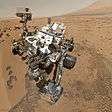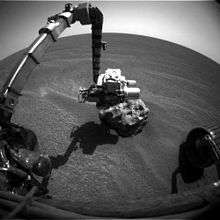Navcam

Curiosity's self-portrait shows the deck of the rover as viewed from the NavCams.
Navcam, short for navigational camera, is a type of camera found on certain unmanned rovers or spacecraft used for navigation without interfering with scientific instruments.[1][2][3] Navcams typically take wide angle photographs that are used to plan the next moves of the vehicle[4] or object tracking.[1]
The Mars Curiosity rover has two pairs of black and white navigation cameras mounted on the mast to support ground navigation. The cameras have a 45 degree angle of view and use visible light to capture stereoscopic 3-D imagery.[5] These cameras, like those on the Mars Pathfinder missions support use of the ICER image compression format. European Space Agency Rosetta spacecraft uses single camera with 5 degree field of view and 12 bit 1024x1024px resolution allowing for visual tracking on each of spacecraft approaches to the asteroids and finally the comet.[1]
See also
References
 |
Look up Navcam in Wiktionary, the free dictionary. | |
|


